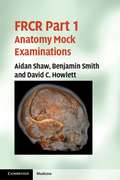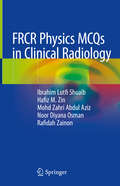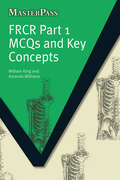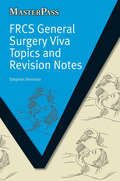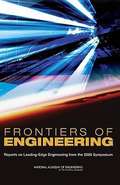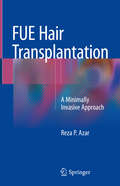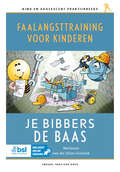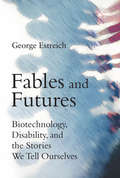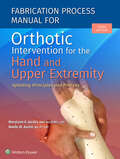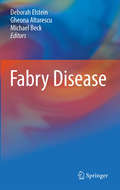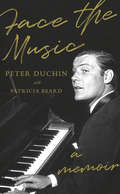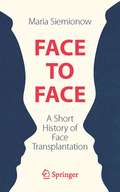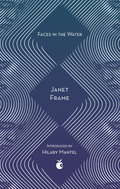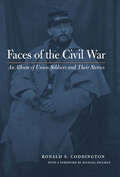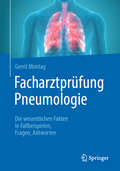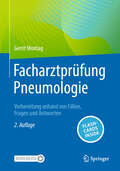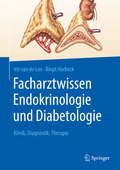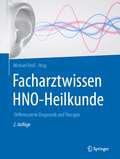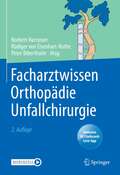- Table View
- List View
FRCR Part 1 Anatomy Mock Examinations
by Benjamin Smith David C. Howlett Aidan ShawFRCR Part 1 Anatomy Mock MCQ Examinations provides essential practice for the new anatomy examination introduced by the Royal College of Radiologists. Written according to the syllabus set by the Royal College, each mock examination is laid out and structured in the same way as the actual papers, ensuring users gain familiarity with both the content and the style. Containing 10 mock examinations and 200 high quality MRI, CT, ultrasound, fluoroscopy, angiography and plain film images, all anatomical areas are covered, including normal variants and paediatric cases. By the end of the book, readers will have encountered every imaging modality and the majority of cases covered in the exam itself. Written by specialist registrars and a highly experienced radiology consultant and Fellowship examiner, FRCR Part 1 Anatomy Mock MCQ Examinations is the must-have revision tool for all Part 1 FRCR candidates.
FRCR Physics MCQs in Clinical Radiology
by Ibrahim Lutfi Shuaib Hafiz M. Zin Mohd Zahri Aziz Noor Diyana Osman Rafidah ZainonThis book offers a collection of specimen multiple choice questions (MCQs) for the first FRCR examination in clinical radiology that is for the physics module. It includes questions arranged in nine sets of 40 MCQs following the examination format. Additionally, chapters cover explanation to some of the answers for better understanding of the topics. The book covers updated syllabus of Royal College of Radiology (RCR), UK on scientific basis of medical imaging, including topics in molecular imaging. Each chapter with a practice set comprises of questions arranged in the order of the syllabus of the examination, starting from the basis of medical imaging and radiation physics to the principles of specific modalities and safety issues. This book offers assistance to candidates preparing for the first FRCR examination, clinical radiology trainees, and radiology and nuclear medicine postgraduate students.
FRCR: Pt. 1 (MasterPass)
by William King Amanda WilliamsThis concise and completely up-to-date study guide bridges the gap between a physics textbook and a self-test format exam aid. It comprehensively covers all the areas examined in the FRCR part 1, and by focusing on understanding the key concepts, rather than simply being able to answer questions correctly, this guide adopts a comprehensive, wide-ranging approach. It includes the latest updated radiation safety legislation (IR(ME)(A)R), and all information has been checked by a medical physicist as well as radiologists. The unique format features self-test MCQs with correct answers and associated key concepts. Test yourself over an entire topic, then check your answers at the back of the book. If you were not successful, you will not only be able to find the correct answers, you will understand where you have gone wrong. This book is highly recommended for candidates for the Fellowship of the Royal College of Radiologists (FRCR) part 1 examination.
FRCS General Surgery Viva Topics and Revision Notes (MasterPass)
by Stephen BrennanWhat are the indications for necrosectomy? How you perform an EUA for acute peri-anal sepsis? What do you understand by the term Early Goal-Directed Therapy (EGDT)? Remember: this is a consultant's exam, and giving a range of options is not good enough. You must tell the examiner what you as a consultant are going to do. The FRCS is a uniquely challenging prospect; highly detailed, wide-ranging and encompassing both theory and practice. Preparation for this exam can be very difficult, and resources tailored to it are scarce. As the consolidated notes of a recent successful candidate, this book is an essential resource when preparing for the viva. The wide variety of questions require you to define, diagnose or choose between treatment options, while MCQs and SBAs help you to objectively evaluate your progress - a unique supplement to your study plan. Answers provided are comprised of an invaluable combination of detailed written answers and lists that will remind you of key points and help you structure your preparation.
FRONTIERS OF ENGINEERING: Reports on Leading-Edge Engineering from the 2008 Symposium
by National Academy of Enegineering National of the National AcademiesEvery year at the U.S. Frontiers of Engineering Symposium, 100 of this country's best and brightest engineers, ages 30 to 45, have an opportunity to learn from their peers about pioneering work being done in many areas of engineering. The symposium gives early career engineers working in academia, industry, and government in many different engineering disciplines an opportunity to make contacts with and learn from individuals they would not meet in the usual round of professional meetings. This networking may lead to collaborative work and facilitate the transfer of new techniques and approaches. It is hoped that the exchange of information on current developments in many fields of engineering will lead to insights that may be applicable in specific disciplines and thereby build U.S. innovative capacity. Different topics are covered each year, and, with a few exceptions, different individuals participate. The four general topics covered at the 2008 meeting were: drug delivery systems, emerging nanoelectronic devices, cognitive engineering, and countering the proliferation of weapons of mass destruction. The intent of this book is to convey the excitement of this unique meeting and to highlight cutting-edge developments in engineering research and technical work.
FUE Hair Transplantation: A Minimally Invasive Approach
by Reza P. AzarThis book provides a comprehensive overview of hair transplantation using the Follicle Unit Extraction method, and is the translation of the successful German edition. Following a brief introduction to the topic and explaining key terms used in hair surgery, it discusses one of the most common reasons for hair loss - androgenic alopecia in men and women. The main body then describes the surgical procedure for the Follicle Unit Extraction (FUE) method, including prerequisites for donor and recipient sites, and postoperative care. The result of this minimally invasive procedure are detailed in a wealth of high-quality pictures. The punch and the FUT technique are highlighted as sampling methods. Rounding off the coverage of this highly interesting topic, the book summarizes the latest findings and offers an outlook on further developments.This book offers a valuable guide for all plastic surgeons and dermatologists interested in performing this technique at their practices.
FXTAS, FXPOI, and Other Premutation Disorders
by Flora Tassone Deborah A. HallThis book should serve as a resource for professionals in all fields regarding diagnosis, management, and counseling of patients with FXTAS, FXPOI and their families, as well as presenting the molecular basis for disease that may lead to the identification of new markers to predict disease risk and eventually lead to target treatments. The book will present information on all aspects of FXTAS, FXPOI and other premutation disorders including clinical features and current supportive management, radiological, psychological, and pathological findings, genotype-phenotype relationships, animal models and basic molecular mechanisms. Genetic counseling issues are also discussed.
Faalangsttraining voor kinderen: Je bibbers de baas (Kind en adolescent praktijkreeks)
by Marianne van der Zalm-GrisnichDit boek is een cognitief gedragstherapeutisch (groeps)behandelprotocol waarmee therapeuten kinderen tussen de 9 en 12 jaar leren met hun faalangst om te gaan en deze te verminderen. Dit protocol is door het NJI erkend als ‘goed onderbouwde jeugdinterventie’ en geschreven voor orthopedagogen, kinderpsychologen, gedragstherapeuten en psychotherapeuten. Deze tweede, herziene versie van Je bibbers de baas combineert cognitieve gedragstherapie met ontspanningstechnieken, psycho-educatie en onderdelen uit de Acceptance and Commitment Therapy. Ook komt de rol van mindset aan bod. Verder zijn energizers toegevoegd en is er aandacht voor terugvalpreventie. Ook bevat de handleiding nu een hoofdstuk over gebruik in bijzondere situaties, zoals het voortgezet onderwijs, klassikaal gebruik, individuele inzet en gebruik bij kinderen met ontwikkelingsproblemen. Het protocol bestaat uit tien kinderbijeenkomsten en twee ouder- en leerkrachtbijeenkomsten. Kinderen werken in hun eigen werkboek (apart verkrijgbaar). Voor ouders en leerkrachten is er een online werkboek. Deze en meer online materialen zijn toegankelijk met behulp van een code in de handleiding.
Fables and Futures: Biotechnology, Disability, and the Stories We Tell Ourselves (The\mit Press Ser.)
by George EstreichHow new biomedical technologies—from prenatal testing to gene-editing techniques—require us to imagine who counts as human and what it means to belong.From next-generation prenatal tests, to virtual children, to the genome-editing tool CRISPR-Cas9, new biotechnologies grant us unprecedented power to predict and shape future people. That power implies a question about belonging: which people, which variations, will we welcome? How will we square new biotech advances with the real but fragile gains for people with disabilities—especially when their voices are all but absent from the conversation?This book explores that conversation, the troubled territory where biotechnology and disability meet. In it, George Estreich—an award-winning poet and memoirist, and the father of a young woman with Down syndrome—delves into popular representations of cutting-edge biotech: websites advertising next-generation prenatal tests, feature articles on “three-parent IVF,” a scientist's memoir of constructing a semisynthetic cell, and more. As Estreich shows, each new application of biotechnology is accompanied by a persuasive story, one that minimizes downsides and promises enormous benefits. In this story, people with disabilities are both invisible and essential: a key promise of new technologies is that disability will be repaired or prevented.In chapters that blend personal narrative and scholarship, Estreich restores disability to our narratives of technology. He also considers broader themes: the place of people with disabilities in a world built for the able; the echoes of eugenic history in the genomic present; and the equation of intellect and human value. Examining the stories we tell ourselves, the fables already creating our futures, Estreich argues that, given biotech that can select and shape who we are, we need to imagine, as broadly as possible, what it means to belong.
Fabrication Process Manual for Orthotic Intervention for the Hand and Upper Extremity
by MaryLynn Jacobs Noelle AustinCompanion to the comprehensive hand therapy text, Orthotic Intervention for the Hand and Upper Extremity: Splinting Principles and Process This comprehensive manual is the perfect resource for use in the classroom, during labs, and in clinical practice for both occupational and physical therapists. Additionally, it is a great reference for those studying to become a Certified Hand Therapist (CHT). The Fabrication Process Manual complements the main text, Orthotic Intervention for the Hand and Upper Extremity: Splinting Principles and Process, and clearly presents step-by-step instructions for the fabrication of the orthoses as well as providing alternative orthotic treatment options. The various orthoses and techniques presented allow the therapist to tailor each orthosis for the specific patient.
Fabry Disease
by Michael Beck Deborah Elstein Gheona AltarescuFabry disease is an X-linked inborn error of metabolism wherein deficiency of a lysosomal enzyme results in systemic deposition of glycosphingolipids. Storage deposition, and hence pathological disease, occurs preferentially in renal glomerular and tubular epithelial cells, myocardial cells, heart valve fibrocytes, neurons of dorsal root ganglia, and in endothelial smooth muscle cells of blood vessels. Thus, Fabry disease is a multi-system disorder, albeit with considerable phenotypic heterogeneity in onset and in severity; however, it is progressive, exhibits extensive morbidity, and is life-threatening. Within the past two decades, there has been a radical change in the natural course Fabry disease by virtue of the availability of specific enzyme replacement therapy. Moreover, there has been a concerted effort to better understand the underlying pathology and equally to identify patients prior to the onset of irreversible end-organ damage. It is to be hoped that the future for patients with Fabry disease can be viewed with greater, albeit guarded, optimism. This state-of-the-art textbook attempts to bridge the span of pre-clinical studies, clinical finding, and management options in a readable but comprehensive manner for the medical practitioner as well as the interested non-medical reader.
Face Transplantation
by Juan P. Barret Veronica TomaselloThis book brings together all the relevant available science behind face transplants. It is comprehensive in its coverage, encompassing patient and donor evaluation, ethics, legal issues, psychological issues, types of transplant, surgical technique, issues relating to immunosuppression, follow-up protocols, and current outcomes. Facial transplantation, which allows the replacement of missing anatomy with a perfect match based on transplant medicine principles, has become the most striking innovation in plastic surgery of the twenty-first century as surgeons and scientists progress from reconstructive surgery to restorative surgery. A robust team approach is, however, necessary to produce safe and efficient outcomes, and numerous questions are arising, from technical issues to ethical dilemmas. The reader will discover in this volume all the information required in order to understand this new discipline and to be able to set up a program of facial transplantation.
Face the Music: A Memoir
by Peter Duchin Patricia BeardIn this poignant memoir, the internationally celebrated bandleader reflects on family, illness, grief, and a bygone era of glamour, contemplating not just his career but the history of midcentury music and nightlife—and the enormously important role that the bandstand played in his life. The internationally-famous bandleader Peter Duchin's six decades of performing have taken him to the most exclusive dance floors and concert halls in the world. He has played for presidents, kings, and queens, as well as for civil rights and cultural organizations. But in 2013, Duchin suffered a stroke that left him with limited use of his left hand, severely impacting his career. Days of recuperating from his stroke—and later from a critical case of Covid-19—inspired Duchin to reconsider his complicated past. His father, the legendary bandleader Eddy Duchin, died when Peter was twelve; his mother, Marjorie Oelrichs Duchin, died when he was just six days old. In the succeeding decades, Duchin would follow his father to become the epitome of mid-20th Century glamour. But it was only half a century later, in the aftermath of his sudden illnesses, that he began to see his mother and father not just as the parents he never had, but as the people he never got to know; and at the same time, to reconsider the milieu in which he has been both a symbol and a participant. More than a memoir, Face the Music offers a window into the era of debutantes and white-tie balls, when such events made national headlines. Duchin explores what &“glamour&” and &“society&” once meant, and what they mean now. With sincerity and humor, Face the Music offers a moving portrait of an extraordinary life, its disruptions, and revitalization.
Face to Face with Emotions in Health and Social Care
by Benjamin GrayThis book draws from the everyday experiences as well as the harsh realities confronting behavioral care providers on the frontline. The book recounts the stories and sometimes disturbing emotions of people whose lives have undergone sudden change or even drastic trauma; people whose feelings of comfort and safety have been shattered by exposure to illness, abuse, death and bereavement. The perspectives and experiences of nurses, social care staff, patients, children and families are at the core of understanding the importance, challenges and therapeutic vitality of emotions. The 55 individuals on the frontline who took part in the interviews on which this study is based discuss the emotions associated with care in mental health, pediatric oncology, AIDS/HIV, as well as child protection and abuse, racism, refugee exile, poverty, and social exclusion. Their bravery, openness, and ability to communicate and share their emotions make this book possible.
Face to Face with the Face: Working with the Face and the Cranial Nerves through Cranio-Sacral Integration
by Thomas Attlee R.C.S.T. Dr Granville Orthodontist L. D. S. R. C. S. E Lond Dr Wojciech TarnowskiPractical and clear, this comprehensive guide to cranio-sacral treatment of the face explains treatment approaches that can make a significant difference to persistent and intractable conditions, enabling profound transformation in quality of life through whole-person integration. The book explores the eyes, ears, nose, sinuses, mouth, teeth and jaw, and provides a practical means of resolving the multitude of conditions affecting these crucial areas in a gentle, non-invasive manner, utilising the body's inherent healing potential. It covers a wide range from persistent ear infections, dental disturbances, facial injury, sinusitis and trigeminal neuralgia, one of the most painful conditions known to the medical world, through to identifying hidden causes of migraine, autism and chronic fatigue and patterns of ill health arising from birth, early childhood and past trauma. Cranial nerve dysfunctions, including polyvagal disturbances, are also included. Hand positions and contacts are clearly presented with over 200 colour photographs and anatomical drawings. A comprehensive presentation of the potential cooperation between dentistry and cranio-sacral therapy is also provided, with contributions from two eminent dentists, providing much needed information on this growing field of integrative medicine. Essential reading in this rapidly expanding area of practice, the book is fully illustrated in colour.
Face to Face: A Short History of Face Transplantation
by Maria SiemionowThis book creatively communicates the human and professional sides of the journey to the first ever near total face transplant, the response to this milestone in the medical community, and the effect it has had on the individuals involved. It focuses on the evolution of Professor Maria Siemionow as a microsurgeon and the processes by which she sensationally overcame the challenges her team encountered including the successful manipulation of the immune system to avoid rejection of the face tissue by the recipient. Face to Face: A Short History of Face Transplantation combines the medical and human elements of the development of face transplant surgery. It is not only targeted at the surgical professional and trainee, but also the general public who wish to read about the journey of how a significant medical advancement was made. It is also great reading to inspire girls of an age where they are thinking about career paths to believe they can do something extraordinary and could persuade some to pursue a career in an STEM subject.
Facemaker
by William KatzA prominent Plastic Surgeon offers his services to accident victims. His creations are experimental. But with a new face, the double victims are murdered.
Faces In The Water (Virago Modern Classics #142)
by Janet Frame'Janet Frame's luminous words are the more precious because they were snatched from the jaws of the disaster of her early life . . . and yet to read her is no more difficult than breathing' Hilary Mantel When Janet Frame's doctor suggested that she write about her traumatic experiences in mental institutions in order to free herself from them, the result was Faces in the Water, a powerful and poignant novel. Istina Mavet descends through increasingly desolate wards, with the threat of leucotomy ever present. As she observes her fellow patients, long dismissed by hospital staff, with humour and compassion, she reveals her original and questing mind. This riveting novel became an international classic, translated into nine languages, and has also been used as a medical school text.Books included in the VMC 40th anniversary series include: Frost in May by Antonia White; The Collected Stories of Grace Paley; Fire from Heaven by Mary Renault; The Magic Toyshop by Angela Carter; The Weather in the Streets by Rosamond Lehmann; Deep Water by Patricia Highsmith; The Return of the Soldier by Rebecca West; Their Eyes Were Watching God by Zora Neale Hurston; Heartburn by Nora Ephron; The Dud Avocado by Elaine Dundy; Memento Mori by Muriel Spark; A View of the Harbour by Elizabeth Taylor; and Faces in the Water by Janet Frame
Faces of the Civil War: An Album of Union Soldiers and Their Stories
by Ronald S. CoddingtonArchival images and biographical sketches of Union soldiers tell the stories of their lives during and after the Civil War.Before going off to fight in the Civil War, many soldiers on both sides of the conflict posed for a carte de visite, or visiting card, to give to their families, friends, or sweethearts. Invented in 1854 by a French photographer, the carte de visite was a small photographic print roughly the size of a modern trading card. The format arrived in America on the eve of the Civil War, which fueled intense demand for the convenient and affordable keepsakes. Considerable numbers of these portrait cards of Civil War soldiers survive today, but the experiences—and often the names—of the individuals portrayed have been lost to time. A passionate collector of Civil War–era photography, Ron Coddington became intrigued by these anonymous faces and began to research the history behind them in military records, pension files, and other public and personal documents.In Faces of the Civil War, Coddington presents 77 cartes de visite of Union soldiers from his collection and tells the stories of their lives during and after the war. The soldiers portrayed were wealthy and poor, educated and unschooled, native-born and immigrant, urban and rural. All were volunteers. Their personal stories reveal a tremendous diversity in their experience of war: many served with distinction, some were captured, some never saw combat while others saw little else. The lives of those who survived the war were even more disparate. While some made successful transitions back to civilian life, others suffered permanent physical and mental disabilities, which too often wrecked their families and careers. In compelling words and haunting pictures, Faces of the Civil War offers a unique perspective on the most dramatic and wrenching period in American history.
Facharztprüfung Pneumologie: Die wesentlichen Fakten in Fallbeispielen, Fragen, Antworten
by Gerrit MontagSie stehen kurz vor Ihrer Facharztprüfung zum Pneumologen oder wollen demnächst in der Pneumologie arbeiten: Mit diesem Werk können Sie Ihr bereits erworbenes Wissen überprüfen, optimal ergänzen und auffrischen. Sowohl typische aber auch seltene Fälle werden anhand Frage-Antwort-Kombinationen erörtert und ermöglichen einen schnellen und fokussierten Wissenserwerb. Die Aktualität der Themen wird Ihnen das kurzfristige Durchforsten der unüberschaubaren wissenschaftlichen Literatur kurz vor der Prüfung zum Pneumologen weitestgehend ersparen.Die an die Pneumologie angrenzenden Fachbereiche Beatmungsmedizin, Infektiologie, Onkologie, Pharmakologie und Schlafmedizin werden in diesem Werk ausführlich mit abgehandelt. Auch gern zitierte Studien und deren Inhalte werden berücksichtigt. Ideal zur Facharztvorbereitung für angehende Pneumologen sowie für interessierte Internisten/Allgemeinmediziner am Fach Pneumologie.Der Autor Dr. med. Gerrit Montag, Oberarzt Innere Medizin/Pneumologie, Oberarzt der medizinischen Intensivstation, Krankenhaus Bad Arolsen. Internist, Pneumologe, Notfallmediziner, Intensivmedizin, Antibiotic-Stewardship-Experte.
Facharztprüfung Pneumologie: Vorbereitung anhand von Fällen, Fragen und Antworten
by Gerrit MontagSie stehen kurz vor Ihrer Facharztprüfung zum Pneumologen oder wollen demnächst in der Pneumologie arbeiten: Mit diesem Werk können Sie Ihr bereits erworbenes Wissen überprüfen, optimal ergänzen und auffrischen. Sowohl typische aber auch seltene Fälle werden anhand Frage-Antwort-Kombinationen erörtert und ermöglichen einen schnellen und fokussierten Wissenserwerb. Die Aktualität der Themen wird Ihnen das kurzfristige Durchforsten der unüberschaubaren wissenschaftlichen Literatur kurz vor der Prüfung zum Pneumologen weitestgehend ersparen.Die an die Pneumologie angrenzenden Fachbereiche Beatmungsmedizin, Infektiologie, Onkologie, Pharmakologie und Schlafmedizin werden in diesem Werk ausführlich mit abgehandelt. Auch gern zitierte Studien und deren Inhalte werden berücksichtigt. Ideal zur Facharztvorbereitung für angehende Pneumologen sowie für interessierte Internisten/Allgemeinmediziner am Fach Pneumologie. U.a. neu in der 2. Auflage: kostenlose Nutzung der Springer Nature Flashcards App zum Lernen zu jeder Zeit und an jedem Ort.
Facharztwissen Angiologie: zur Vorbereitung auf die Facharztprüfung
by Malte LudwigDieses Buch basiert auf den erforderlichen Inhalten für die Facharztprüfung im Schwerpunkt Angiologie und deckt knapp, übersichtlich und leitlinienorientiert die hierfür notwendigen angiologischen, phlebologischen und lymphologischen Kenntnisse ab.Es wendet sich an Weiterbildungsassistenten in der Inneren Medizin, die die Facharztprüfung für Innere Medizin und Angiologie anstreben. Es eignet sich jedoch nicht nur ideal zur raschen und zuverlässigen Vorbereitung auf die Angiologieprüfung, sondern vermittelt auch Grundlagenwissen für alle weiteren an der Vaskulärmedizin interessierten Ärztinnen und Ärzte.
Facharztwissen Endokrinologie und Diabetologie: Klinik, Diagnostik, Therapie
by Birgit Harbeck Iris van de LooDieses Buch bietet kompakt das gesamte praxisrelevante Wissen zu Hormonen und Stoffwechsel. Oft handelt es sich um angeborene bzw. chronische Erkrankungen. Hier ist es wichtig, frühzeitig die richtigen Weichen zu stellen und die potentiell lebenslange Therapie optimal auf den Patienten anzupassen. Diagnostik, Differentialdiagnostik Leitsymptome, FrüherkennungWelche Verdachtsdiagnose ist plausibel?Erkrankungen zuverlässig nachweisen bzw. ausschließenWelche Begleit- und Folgeerkrankungen müssen bedacht werden?Stufendiagnostik: Was ist medizinisch und wirtschaftlich sinnvoll und effizientTestdurchführung und –auswertungVerlaufskontrolle: Was, wann, wie häufig Therapiestrategien Individuell auf den Patienten abgestimmt(Alter, Schwangerschaft, Begleiterkrankungen, Lebensumstände …)Konservativ/operativ – interdisziplinär abgestimmtKomplikationenVerlauf, Prognose, Nachsorge, Beratung für Patienten und Familienangehörige Konkret und zuverlässig Zahlen, Fakten, Dosierungen in zahlreichen Algorithmen und TabellenTipps für die Praxis (z.B. Verhalten bei Sport, Reisen), FAQs, typische FehlerFallbeispiele Für die FacharztprüfungLern- und Strategiebuch, um sicher die Facharztprüfung Innere Medizin und Endokrinologie und Diabetologie zu bestehen.Für den erfahrenen AnwenderNachschlagewerk für den klinisch-praktischen Alltag für Endokrinologen, Internisten, Allgemeinmediziner, Gynäkologen, pädiatrische Endokrinologen, Nuklearmediziner.
Facharztwissen HNO-Heilkunde: Differenzierte Diagnostik und Therapie
by Michael ReißUnter dem Druck zunehmender Arbeitsverdichtung wird die Ressource Zeit für Ärzte immer knapper. Das Buch ist so gestaltet, dass eine zeitsparende Informationsaufnahme möglich ist – ohne dabei auf die notwendige Tiefe zu verzichten. Im Mittelpunkt stehen detaillierte und differenzierte Empfehlungen zu Diagnostik und Therapie in der HNO-Heilkunde. Tabellen, Algorithmen und schematische Übersichten liefern einen schnellen Überblick. Das Buch dient der effizienten Prüfungsvorbereitung oder als Nachschlagewerk während der täglichen Routine.
Facharztwissen Orthopädie Unfallchirurgie
by Peter Biberthaler Norbert Harrasser Rüdiger von Eisenhart-RotheDieses Buch dient der effizienten Vorbereitung auf die Facharztprüfung oder als Nachschlagewerk in der täglichen Routine. Es ist so gestaltet, dass eine zeitsparende Informationsaufnahme möglich ist, ohne dabei auf die notwendige Tiefe zu verzichten. Im Mittelpunkt stehen detaillierte und differenzierte Empfehlungen zur Diagnostik und Therapie. Algorithmen, schematische Übersichten und brillante Abbildungen veranschaulichen darüber hinaus die Inhalte. Für die 2. Auflage wurden alle Inhalte überarbeitet und aktualisiert. Darüber hinaus wurde die 2. Auflage um über 1.000 digitale Dateikarten mit Fragen und Antworten („FlashCards“) erweitert, mit deren Hilfe man die wesentlichen fachlichen Inhalte "pauken" kann. Im neuen Kapitel "Die Facharztprüfung in der Praxis" wird exemplarisch eine Facharztprüfung in Frage und Antwort durchgespielt. So bekommt man eine gute Vorstellung davon, wie eine Facharztprüfung tatsächlich abläuft und welche Antworten und welches Wissen in der Prüfung erwartet wird.
